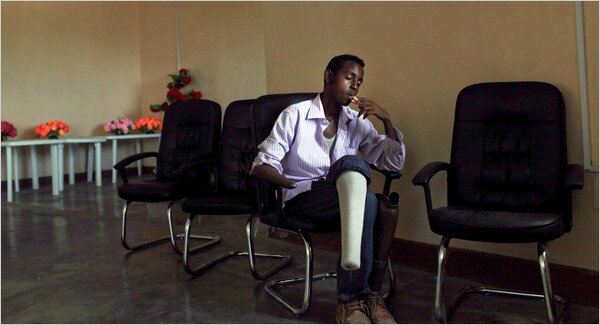Somali Backlash May Be Militants’ Worst Foe

By JEFFREY GETTLEMAN — MOGADISHU, Somalia — For the past three years, the Shabab, one of Africa’s most fearsome militant Islamist groups, have been terrorizing the Somali public, chopping off hands, stoning people to death and banning TV, music and even bras in their quest to turn Somalia into a seventh-century-style Islamic state.
At the same time, they have drawn increasingly close to Al Qaeda, deploying suicide bombers, attracting jihadists from around the world and prompting American concerns that they may be spreading into Kenya, Yemen and beyond.
But could Somalia finally be reaching a tipping point against the Shabab?
Not only is Somalia’s transitional government gearing up for a major offensive against the Shabab — with the American military providing intelligence and logistical support — but Mogadishu’s beleaguered population, sensing a change in the salt-sticky air, is beginning to turn against them.
Women who have been whipped and humiliated by morality police for not veiling their faces are now whispering valuable secrets about the Shabab’s movements into the ears of government soldiers. Teenage students outraged that Shabab-allied fighters hoisted a black flag in front of their school recently pelted the fighters with stones. Defectors are leaving the Shabab in droves, including one 13-year-old who said that he was routinely drugged before being handed a machine gun and shoved into combat.
Since 1991, when Somalia’s central government collapsed, the people here have endured one violent struggle after another, which has reduced the capital, Mogadishu, to ruins and this nation to the archetypal failed state. But never before has the Somali public had such a vested interest in who wins as they do in the coming showdown against the Shabab.
“They are like rabid dogs,†said Dahir Mohamed, a shopkeeper, who still has puffy, oddly circular scars on his face from where he says young Shabab fighters bit him.
The Shabab have defied expectations in the past and proved resilient, determined and formidable. Some Somalia analysts fear that even if the government dislodges the Shabab and ends their ability to operate in the open, they can still wreak havoc with suicide bombs and other guerrilla tactics.
“They will pull out and leave people behind the lines,†said Mark Bowden, head of United Nations humanitarian operations in Somalia.
But if Somalis, who possess considerable firepower of their own, decisively turn against the Shabab, and the government provides people with an alternative to rally behind, it could be difficult for the militants to reconstitute themselves, even as a guerrilla army.
The best example of that backlash is already happening in Medina, a neighborhood a few miles from the center of Mogadishu. Just past the airport, it is a place of sandy streets and once beautiful homes now chewed up by gunfire and mold.
Shabab fighters, in their trademark green jumpsuits and checkered scarves, used to control parts of Medina. But in the last year or so the neighborhood, dominated by a single clan, banded together to drive them out.
Young men joined the local militia. Old men raised money for guns. Women and girls hauled ice, rice and milk to the front lines and braved gunfire to evacuate the casualties.
“We hate the Shabab,†said one mother, Amina Abdullahi Mohamed. “They misled our youth.â€
Medina is now one of Mogadishu’s safest areas, and while still not particularly safe, an unmistakable beat of life has returned.
There has not been a suicide attack for months. The markets are packed, protected by baby-faced militiamen in polo shirts and Kalashnikov rifles over their shoulders. Beat-up old minibuses cruise the streets, and there is even something close to traffic. A tight clan network keeps a watchful eye and last month, a teacher of the Koran recruiting children for the Shabab was promptly arrested.
Medina is a picture of Somalia’s past and possibly its looming future. Clan militias carved this country into fiefs in the 1990s, which lasted until 2006, when an Islamist alliance, which included the Shabab, took over and held most of Somalia relatively peacefully. The Ethiopian military then invaded, sparking an intense guerrilla war, with the Shabab spearheading the resistance.
But after the Ethiopians pulled out last year and Sheik Sharif Sheik Ahmed, an Islamist cleric, was selected as the transitional government’s president, grass-roots support for the Shabab began to fade. It has sunk ever since, though the Shabab and their allies still control more than half of south central Somalia.
But if government troops retake areas in the offensive, they will need the help of clan militias, like Medina’s, to hold them. A similar arrangement is also in place in parts of central Somalia, where a moderate Islamist militia pushed out the Shabab last year.
“I’m not saying Somalia’s going to be a modern state,†said one American official “But it won’t be a radical Islamic state either.â€
The Shabab seem to be rapidly ruining any chances of that. Defections, double-crossings and internal strife are increasingly plaguing their movement, according to many Somalis.
A few weeks ago, Somali security officials said that an explosion rocked a Shabab hide-out, leaving dozens dead. Somali security services said it was one Shabab faction trying to wipe out another, evidence of a possible new rift between Somali Shabab and the several hundred foreign jihadists who had joined their movement.
The Shabab also seem short of cash to support their estimated 3,000 hard-core fighters and 2,000 allied gunmen. They recently began taxing aid convoys, causing the United Nations World Food Program to leave several Shabab areas in January, but new recruits seem to be another problem. Defectors said the Shabab have begun plucking children off soccer fields, taking them to secret training camps, brainwashing and drugging them.
The Shabab seem to be traveling down the same degenerative path of countless other African rebel groups that began with a discernible ideology, but then turned to terrorizing the very people they were supposed to liberate.
Public executions and gruesome amputations are ways they hold the population in check. Most Somalis are conservative Muslims, but they chafe under the Shabab’s austere Salafi version of Islam.
One 17-year-old boy remembered the day last June when Shabab fighters chained him to a gurney and dragged him in front of a huge crowd.
“Ismael Khalif Abdallah,†the fighters said, reading out the boy’s name, “is a thief. He has been robbing people. It’s time to punish him.â€
For the next 10 minutes, the men sawed through Ismael’s wrist bones. Then they cut off his foot. Just recounting the pain and terror makes Ismael’s hairless face break out in sweat.
“Now what?†he says, struggling to light a cigarette with his stub of an arm.
____
New York Times
Comments
comments
 Calendar
Calendar






































